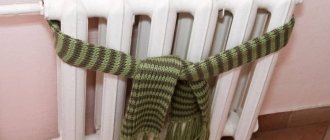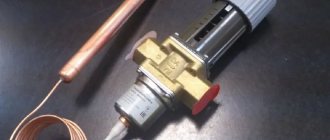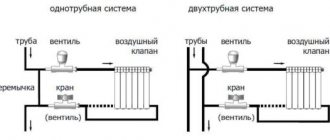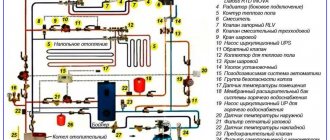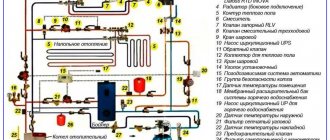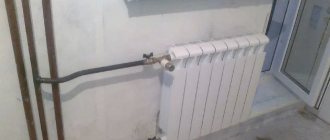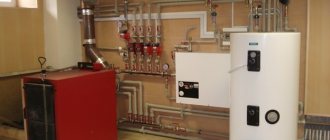The house still smells like a fresh renovation, but the heating radiators are no longer working as well as you would like? What is the problem, why are not all sections heated, or is the battery only heated in the upper part, and is it cold at the bottom?
All heating batteries are completely new, but the efficiency of the heating system leaves much to be desired.
Such problems can befall both owners of luxury cottages and residents of ordinary country houses and apartments.
Those who encountered this problem in the autumn were also lucky, when the outside air temperature was not yet too close to zero. In this case, there is a small amount of time left to carry out routine diagnostics and repairs.
What should those “lucky ones” do, whose radiator stopped warming up right in the Epiphany frosts or even on New Year’s Eve? Then they have to spend the entire New Year holidays looking for a sober plumber. And it’s good if these searches are crowned with success.
Did the unexpected appearance of these symptoms seem like the worst disaster to you? In fact, the lack of obvious prerequisites for this is the main problem!
And in this case it has to be solved through trial and error.
Of course, it is impossible to reduce the probability of suddenly losing heating to zero, but you definitely need to know the main reasons that contribute to the transformation of your home into the residence of Santa Claus.
Why batteries in a private house do not heat well, what to do
But, unfortunately, the coolant enters the radiator in a non-optimal manner, i.e.
not into the upper, but into the lower radiator manifold. We have already written in more detail about what to do if the batteries do not heat up. What can we say about secondary housing built 30-40 years ago. Where to go and how to behave correctly in order to quickly “warm up” the batteries? Why do batteries heat poorly in a private home? The reason may be an incorrectly selected boiler power. That is, it does not have enough resources to heat the required amount of liquid. If no problems are found with the boiler and it is working correctly, then the reason why the batteries are cold should be looked for in the circuit itself. If the batteries are cold, then you need to check all the above factors. You will have to drain water from cold radiators in a private house. What to do is known, you need to unscrew one end (bottom) of the battery and substitute a larger vessel.
We will separately consider the disruption of coolant circulation due to improper pipe routing and piping of heat exchangers, as a result of which the batteries are cold. There may be several reasons why the batteries, instead of delighting with their “hot temperament,” are a little lukewarm. This is easy to do: place your hand on the riser, and then on each of the batteries. Insufficient heating of the battery may be due to the fact that an air lock has formed in it, as a result of which hot water cannot fully circulate in it.
In principle, from time to time the air from the system needs to be bleed, without waiting for the problem to manifest itself by a drop in temperature in the batteries. This is a troublesome task, fraught with the risk that water from the radiator will pour onto the floor. In any case, it is better to invite a plumber to do this work. And at the same time let him install at least the simplest Mayevsky cranes on the batteries. The battery is connected to the riser in two places - at the top and bottom. Hot water flows into the battery from the top, washes all its parts from the inside, and flows out from below.
You can help yourself by installing a simple element called a duct extension into the “wrong” battery. Nothing complicated: a regular long tube with one narrowed end, which is inserted into the battery through the top connection. As a result of this, in no part of the battery will the batteries be cold or too hot (heating devices that are located closer to the boiler usually overheat). 16:06 10/20/2011 Even in new buildings, heating problems are not uncommon.
They are no worse or better than cast iron ones, they are simply designed for other hydraulic circuits of heating systems. And this can only be ensured with the relative cleanliness of the pipes and radiators, as well as the non-interference of residents and illiterate housing department (UK) workers in the design design of the entire riser.
After all, roughly speaking, only 1/18th of the coolant is intended for this one radiator. It can be seen that the coolant rising along the riser (for example, the 2nd floor) changes its direction to the left at the turn, and part of it “jumps” into the radiator by inertia.
We can only consider the question in general. There are different reasons and they are not always obvious. In your home, you can say with almost 100% probability that the heating circuit is autonomous. Although in this case the heat exchangers will heat up at least a little. And if the water in them is completely cold, it means that the boiler is broken or cannot turn on.
In addition, there is an automation and security system. In any case, the sensor will send a command to the control unit and it will not allow the boiler to turn on. The specificity of a private house is that all characteristics can be controlled independently. Then make sure there is no dirt in the pipes and heat exchangers. How to do it?
It is necessary to rinse the circuit to clean water. Sometimes thick liquid flows out of radiators along with water. This is dirt collected in copious amounts. In general, in an autonomous circuit the coolant pressure does not exceed two atmospheres. It was believed that it was simpler and cheaper, but in reality this is not the case. In addition, in this scheme it is very difficult to regulate the temperature of the heat exchangers as they move away from the boiler room.
It turns out that water enters the heat exchanger, cools there and is again drawn into the general flow. Accordingly, after each radiator the overall flow becomes colder.
As a result, the water may reach the extreme heat exchanger almost cold. If their temperature is approximately the same cool, your heating radiators have nothing to do with it. They simply cannot provide more heat, since the coolant they receive is not heated enough. In a private house, the boiler may be to blame for this, or you yourself may be to blame, because you purchased a boiler whose power is not enough to heat the entire building. It may very well be that the problem is its incorrect connection to the system.
The riser is hot, but the battery does not heat up!
This complaint is the most popular of all the above. To correctly make a “diagnosis”, you need to consider all the reasons mentioned above.
But other versions are also possible:
- The valves that supply water to the riser are closed or faulty.
- The presence of foreign objects in the pipes, for example, they can get there during the installation of risers.
- Errors when working with pipes in an adjacent room (replacing pipes).
- Reducing the volume of coolant passing through the pipes.
- Defect in the pipe leading to the public main.
- Air locks in the system.
Let's consider the operation of a U-shaped riser in its downward part.
The duct extension is also very inexpensive, but it perfectly solves the problem of poor water circulation in the event of an incorrect connection of the radiator. If you have independent heating, then you are certainly in a better position. If only because by inserting a small device into the system - a circulation pump - you activate the movement of hot water through the pipes and radiators.
Print out the claim in two copies. Transfer one to the DEZ (housing department or other management company). In this case, the reasonable period will be counted from the date the utility company received your letter. In Moscow this is a district government, in other regions - district administrations, village councils, etc.
Installing a circulation pump, what you should pay attention to
To install the circulation pump yourself, use the following recommendations:
- To extend the service life of the entire system, install a filter to clean the liquid in front of the circulation pump. the filter must be installed on the suction pipe;
- do not choose a circulation pump for the heating system with greater power and performance than required. Otherwise, there is a risk of encountering additional unpleasant noise during its operation;
- Never turn on the pump before filling the heating line with water and removing air from it, this can lead to equipment failure;
- install the pump in an area as close as possible to the expansion tank;
- When installing the pump in a closed heating system, if possible, install the pump on the return line. This is due to the fact that this section of the highway has the lowest temperature.
Installing a circulation pump
Advice: before starting the heating system, it is necessary to rinse it with water to remove various foreign particles. Do not forget that even short-term idle operation of the circulation pump in the absence of liquid in the system can result in failure of the pump itself and other elements of the system.
Almost all circulation pumps on the market today are equipped with a connection to the automatic control of heating boilers. This function provides owners with the opportunity to regulate the air temperature in a heated facility by changing the speed of water movement in the heating system. In order to take into account the level of heat consumption in the premises, special meters are installed, thanks to which heat losses arising due to wear and tear of the lines are controlled. The heating circuit itself is not subject to any changes.
You can learn how to install the circulation pump yourself by watching the video:
Disruption of coolant circulation
This body is authorized to monitor, among other things, the quality of public services, the work of management organizations and issue mandatory orders to violators. Residential multi-storey buildings in the 60s - 90s of the last century, and often even now, are built using a single-pipe vertical heating system.
To simplify, let’s consider such a system in a three-story building. But with such U-shaped risers, many five and nine-story buildings have been built throughout the country. And the operation of such a system was designed exclusively for the use of cast iron radiators. In such houses, looking ahead, it is absolutely forbidden to change the type of heating device. But with the advent of aluminum, and especially bimetallic radiators, a very bad (and even critical) situation arose.
Signs of poor heating
The first sign of heating problems is cold radiators.
When rooms are not heated enough in winter, you can feel it right away. Problems with heating in an apartment make themselves felt by discomfort for the inhabitants, the appearance of dampness on the walls and strange noises spreading through metal pipelines throughout the entire house.
Problems that arise with the heating system can be characterized by a number of symptoms:
- the system as a whole is functioning poorly;
- the heat supply on different floors is not the same;
- radiators in one room are hot, in another barely warm;
- the “warm floor” system warms up unevenly;
- noise and seething in the pipes is heard;
- Coolant is leaking from pipes or radiators.
Why do batteries heat poorly? Part 1.
As mentioned above, in a private home there may be many reasons why the batteries do not heat well
. Here are some of them:
1. Batteries are full.
This is unlikely if you have
autonomous water heating.
Dirt in heating and rust in heating
you never will, even if your heating system is fifty years old.
Why? Because if you have an autonomous heating system at home
, then
dirt
cannot enter the heating system from outside.
Regarding rust in heating
, then it is not available in autonomous water heating either. Why? Because rust does not appear without oxygen. That is, if you do not drain the water in the system for the summer, then oxygen does not enter your heating system. This means there will be no rust in the heating even after fifty years.
2. Hydraulics of the heating system.
A very common reason why
batteries in a private home do not heat well
.
In this case, one heating branch or ring through which water circulates in the heating system
will work well, the other heating branch will work poorly.
This usually happens if your heating system is new,
or if you have added several radiators to an existing heating system.
In this case, some batteries heat up, the last batteries are cold
, due to the fact that the heating hydraulics were incorrectly calculated, that is, the diameter and length of the heating pipe.
Your system may have control valves
in order to
adjust the hydraulics of your heating system
. In this case, it is necessary to adjust the hydraulics of your heating system using control valves.
3.
Single-pipe water heating system.
A single-pipe water heating system is a fairly common system in older homes.
Typically, this system has thick pipes, a heating system of natural coolant circulation
, that is, a non-volatile
heating system without pump circulation.
It works like this: the batteries that are closer to the boiler heat well,
the distant batteries heat worse
, that is,
the last batteries are cold,
this is the normal operation
of a single-pipe water heating system.
Nothing can be changed here, except perhaps converting a single-pipe water heating system to a two-pipe one, that is,
installing a two-pipe heating system
.
Automation for gas heating boilers.
Modern water heating systems are automated and energy-dependent. This includes boilers with built-in automation, pumps, sensors, etc. In this case, you will need the help of a specialist, since the system is quite complex and most likely under warranty. Contact the gas boiler startup service. As a rule, such a service department makes the first start-up of a gas boiler, deals with warranty service and repairs of the gas boiler.
The service specialist will check whether the automation in your water heating system is connected correctly and whether everything is working properly, and also, if necessary, will make the necessary repairs.
Poor quality installation of the heating system
A poorly installed plastic pipe may burst during operation.
It happens that a new, recently installed radiator does not want to heat up.
Others in the system before and after it heat up normally, but this one does not. The reason is poor coolant circulation. The reason for the problem with the heating radiator could have been an oversight by the installer. Probably, when welding a polypropylene pipe, he overheated it too much, and as a result of melting, the internal diameter decreased. In such cases, the installer is obliged to redo his poor-quality work free of charge.
To avoid problems with the heating system, all pipes and fittings included in its composition must be a securely installed structure.
Repair of metal pipelines
Leaks on metal pipes appear as rusty spots
Metal pipes are the most susceptible to corrosion and have the shortest service life compared to more modern materials. However, due to their low cost, such pipes are still widely used. The occurrence of a leak on a metal pipe is manifested by rusty streaks, and it is quite easy to detect. You can weld a fistula in a metal pipe using gas or electrode welding. If the damaged area is large or there are several leaks nearby, then it is better to replace the entire area between the two threaded connections. If the heating pipe is leaking at the junction, then the sealing winding is replaced at the junction of the pipe sections.
Improper ventilation of the boiler room
The method of ventilation depends on the type of combustion chamber. Heaters with an open combustion chamber require gravity ventilation, and the fresh air grille supplying air to the room must have a cross-sectional area of at least 200 cm2.
Of course, it is also necessary to have a vertical ventilation duct of at least 14 14 cm in size or 15 cm in diameter (which also gives a cross-sectional area of about 200 cm2), with an inlet opening near the ceiling.
If the combustion chamber is closed (the boiler takes air from outside, not from the room), then the regulations do not determine what type of ventilation is required. However, this is necessary, if only because in the event of a gas leak in the system, there is a danger of its accumulation.
Steel pipe repair
Steel pipes are usually used in utility or technical rooms. They often have a large diameter, and this feature makes it possible to carry out repairs in unique ways. What to do if a fistula appears in a steel pipe? The following options apply:
- repair using a bolt: the fistula site is drilled out, a thread is cut and the bolt is screwed in;
- eliminating leaks using a temporary bandage or clamps with a sealing gasket (applied if the damaged area has a significant area);
- repair using an adhesive bandage - wrap the damaged area with fiberglass cloth impregnated with sealant (apply at least 6 layers);
- flange connection.
First, the system is turned off and the coolant is drained. Repair work is carried out on a dry and cooled area.
Improving room heating
The speed of movement of the coolant can be increased with a circulation pump
Quite often, property owners have to deal with insufficient heating levels during severe frosts.
You can increase the efficiency of your heating system by installing the following products:
- Centrifugal pump. It must be installed at the outlet by inserting into the feed.
- Copper pipes with better heat transfer.
- Electric or water heated floor.
In some cases, you should change the piping scheme, using a two-pipe option.

